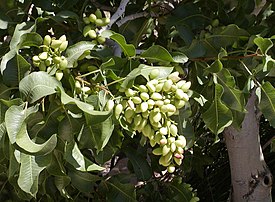Terebinthus pistacia
Əsl püstə (lat. Pistacia vera) — bitkilər aləminin sabunağacıçiçəklilər dəstəsinin sumaqkimilər fəsiləsinin püstə cinsinə aid bitki növü.
| Əsl püstə | ||||||||||
|---|---|---|---|---|---|---|---|---|---|---|
 | ||||||||||
| Elmi təsnifat | ||||||||||
|
Domen: Klad: Ranqsız: Aləm: Klad: Klad: Klad: Klad: Klad: Klad: Klad: Klad: Klad: Klad: Klad: Dəstə: Fəsilə: Yarımfəsilə: Cins: Növ: Əsl püstə |
||||||||||
| Beynəlxalq elmi adı | ||||||||||
| ||||||||||
Təsviri
[redaktə | mənbəni redaktə et]Püstə ağacı 25-35 fut yüksəkliyə qədər böyüyə bilən, uzunömürlü bir bitkidir. Yarpaqları bir neçə kiçik yarpaqcıqlardan ibarət olan mürəkkəb yarpaqlardır. Çiçəkləri dişi və erkək çiçəklər olmaqla ayrı-ayrı ağaclarda inkişaf edir (iki evli bitki).
Püstə meyvəsi bir toxumlu, qabıqlı və çəyirdəkli meyvədir. Toxum adətən yaşıl rəngdə olur və dadı qidalandırıcı, bir qədər şirin və unikal aromaya malikdir.[2] Çəyirdəyin bərk hissəsinin parçalaması seleksiyanın nəticəsidir.[3]
Yayılması
[redaktə | mənbəni redaktə et]Püstə səhra bitkisidir və onun şorakət torpaqlara dözümlüyü yüksəkdir.[4] Onun mənşəyi Əfqanıstan, İran və Mərkəzi Asiya ərazilərindən gəlir.[5][6][7][8]
İstifadəsi
[redaktə | mənbəni redaktə et]Arxeoloji tapıntılar göstərir ki, püstə toxumları artıq e.ə. 6750 ilində yemək üçün istifadə olunurdu.[9] Onun istehlakının ən erkən sübutu, Özbəkistan ərazisində yerləşən, tunc dövrünə aid olan, Carkutan kompleksində aşkar olunub.[10][11]
Püstə ləpələri adətən tam şəkildə, bişməmiş və ya qovrulmuş və duzlanmış şəkildə yeyilir. Onlar həmçinin, püstə dondurması (o cümlədən kulfi, bastani və spumone), püstə yağı,[12][13] püstə pastası,[14] püstə paxlavası, püstə şokoladı,[15] püstə halvası,[16] püstə likörü[17] və s. yeməklərin hazırlamasında işlənilir.
İstehsalı
[redaktə | mənbəni redaktə et]| Ölkə | ton |
|---|---|
| 400,070 | |
| 241,669 | |
| 239,289 | |
| 81,700 | |
| 45,467 | |
| Dünya | 1,026,803 |
| Mənbə: BMT-nin Ərzaq və Kənd Təsərrüfatı Təşkilatı[18] | |
2022-ci ildə dünyanın püstə ləpəsinin ən böyük istehsaçıları ABŞ, İran və Türkiyə idi. Onlar həmin il, birgə, püstə ləpəsinin 88%-i istehsal ediblər.
Sinonimləri
[redaktə | mənbəni redaktə et]Heterotipik sinonimləri
[redaktə | mənbəni redaktə et]- Lentiscus vera Kuntze
- Pistacia badghysi K.P.Popov
- Pistacia macrophylla Pers.
- Pistacia narbonnensis L.
- Pistacia narbonnensis var. bauhini Ten.
- Pistacia nemausensis Req. ex Planch.
- Pistacia nigricans Crantz
- Pistacia officinarum Aiton
- Pistacia reticulata Willd.
- Pistacia trifolia L.
- Pistacia variifolia Salisb.
- Pistacia vera f. semidehiscens K.P.Popov
- Pistacia vera var. trifolia (L.) Poir.
- Terebinthus pistacia Dum.Cours.
İstinadlar
[redaktə | mənbəni redaktə et]- ↑ Linnæi C. Species Plantarum (lat.): Exhibentes plantas rite cognitas ad genera relatas. 1753. C. 2. S. 1025.
- ↑ Parsa, A., & Parsa, H. (2007). "Pistachio Production Manual. Arxivləşdirilib 2024-08-30 at the Wayback Machine" University of California, Agriculture and Natural Resources. Bu kitabda püstə ağacının becərilməsi, məhsul toplanması və işlənməsi ilə bağlı geniş məlumat verilir. Kitabda ABŞ-da püstə istehsalının inkişafı və metodları təsvir edilmişdir.
- ↑ Towards a comprehensive documentation and use of Pistacia genetic diversity in Central and West Asia, North Africa and Europe Arxiv surəti 23 iyun 2021 tarixindən Wayback Machine saytında, Report of the IPGRI Workshop, 14–17 December 1998, Irbid, Jordan – S.Padulosi and A. Hadj-Hassan, editors
- ↑ Esteban Herrera (1997) Growing pistachios in New Mexico, New Mexico State University, Cooperative Extension Service, Circular 532 [1] Arxiv surəti 20 iyul 2011 tarixindən Wayback Machine saytında
- ↑ Marks, Gil. Encyclopedia of Jewish Food (ingilis). HMH. 2010. ISBN 978-0544186316.
These pale green nuts covered with a papery skin grow on a small deciduous tree native to Persia, the area that still produces the best pistachios.
- ↑ "Pistacia vera L. | Plants of the World Online | Kew Science". Plants of the World Online. 24 May 2019 tarixində arxivləşdirilib. İstifadə tarixi: 24 May 2019.
- ↑ "Pistachio | Description, Uses, & Nutrition". Encyclopedia Britannica (ingilis). 8 September 2015 tarixində arxivləşdirilib. İstifadə tarixi: 24 May 2019.
The pistachio tree is believed to be indigenous to Iran.
- ↑ V. Tavallali and M. Rahemi. "Effects of Rootstock on Nutrient Acquisition by Leaf, Kernel and Quality of Pistachio (Pistacia vera L.)" (PDF). American-Eurasian J. Agric. & Environ. Sci. 2 (3). 2007: 240–246. 24 February 2019 tarixində orijinalından (PDF) arxivləşdirilib.
Native P. vera forests are located in north eastern part of Iran particularly in Sarakhs region. This native P. vera is the origin of cultivated pistachio trees in Iran [1]. P. mutica is a wild species indigenous to Iran, growing with almond, oak and other forest trees common to most Alpine regions.
- ↑ "History and Agriculture of the Pistachio Nut". IRECO. 8 July 2006 tarixində orijinalından arxivləşdirilib. İstifadə tarixi: 27 February 2012.
- ↑ D. T. Potts. A Companion to the Archaeology of the Ancient Near East, Volume 1. John Wiley & Sons. 21 May 2012. səh. 199. ISBN 978-1405189880.
- ↑ Harlan Walker. Cooks and Other People. Oxford Symposium. 1996. səh. 84. ISBN 978-0907325727.
- ↑ Ardekani, A. S. H.; Shahedi, M.; Kabir, G. "Optimizing Formulation of Pistachio Butter Production" (PDF). Journal of Science and Technology of Agriculture and Natural Resources. 13 (47). 2009: 49–59. 19 August 2011 tarixində orijinalından (PDF) arxivləşdirilib.
- ↑ Ardakani; Shahedi, M.; Kabir, G. Optimizing of the process of pistachio butter production. Acta Horticulturae. 726. 2006. 565–568. 3 April 2013 tarixində orijinalından arxivləşdirilib. İstifadə tarixi: 4 May 2011.
- ↑ Shakerardekani, A.; Karim, R.; Mohd Ghazali, H.; Chin, N. L. "Effect of roasting conditions on hardness, moisture content and colour of pistachio kernels" (PDF). International Food Research Journal. 18. 2011: 704–710. 2022-01-20 tarixində arxivləşdirilib (PDF). İstifadə tarixi: 2024-10-30.
- ↑ Ardakani. The vital role of pistachio processing industries in development of Iran non-oil exports. Acta Horticulturae. 726. 2006. 579–581. 3 April 2013 tarixində orijinalından arxivləşdirilib. İstifadə tarixi: 4 May 2011.
- ↑ Shaker Ardakai, A.; Mir Damadiha, F.; Salehi, F.; Shahedi, M.; Kabir, G. H.; Javan Shah, A.; və b. "Pistachio Halva Production". Document Number: 29328. Iran Pistachio Research Institute. 2007. 31 December 2018 tarixində orijinalından arxivləşdirilib. İstifadə tarixi: 4 May 2011.
- ↑ The Vatican Cookbook
- ↑ "Pistachio production in 2022, Crops/Regions/World list/Production Quantity/Year (pick lists)". UN Food and Agriculture Organization, Corporate Statistical Database (FAOSTAT). 2024. 7 August 2015 tarixində arxivləşdirilib (PDF). İstifadə tarixi: 20 April 2024.